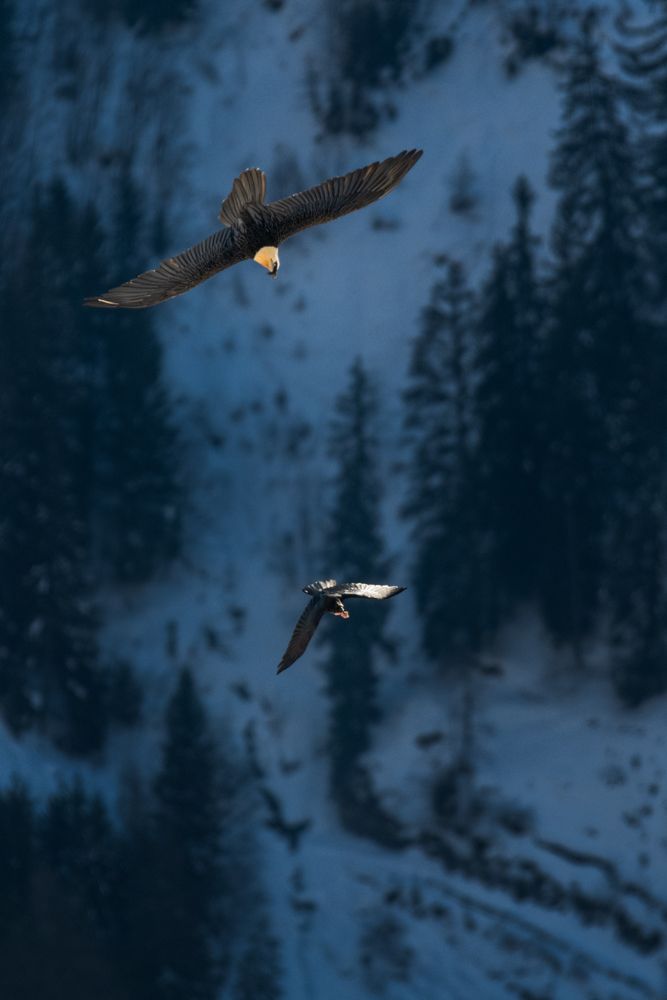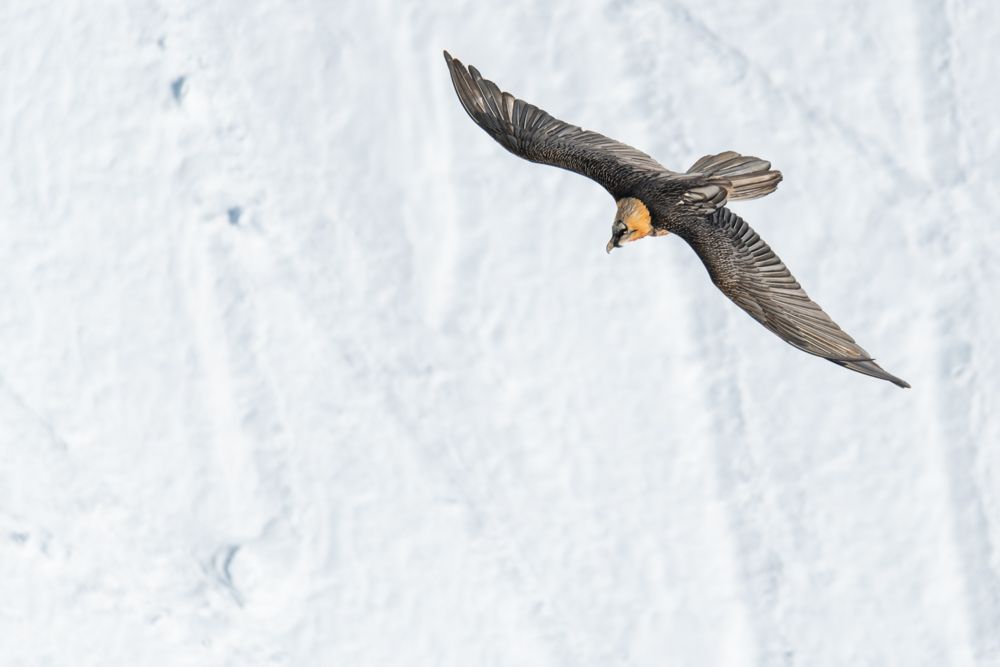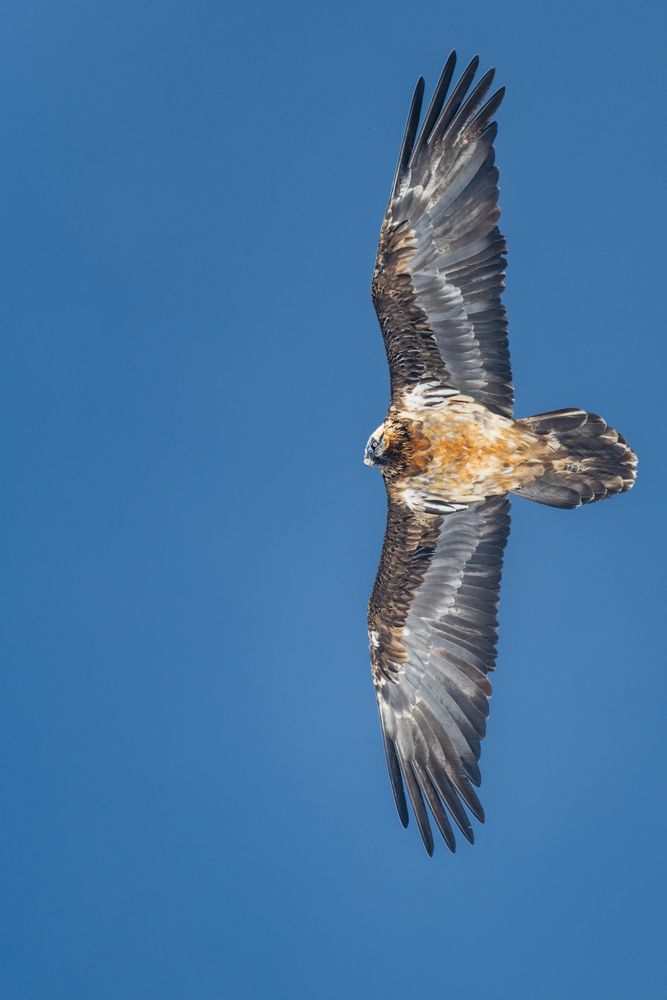Bearded Vulture (Gypaetus barbatus)
With a wingspan of up to 2.8 m, the bearded vulture is the largest bird in the Alpine region. Despite its size, the vulture glides through the Alps for hours without a flap of its wings. A true artist of the air!
Profile
Scientific name: Gypaetus barbatus
Class: Birds
Order: Birds of prey
Family: Hawks
Length: 100-115 cm
Wingspan: 250-280 cm
Weight: 5-7 kg
Distribution: Central and Southern Europe, East Africa, West Asia
Breeding population CH: 9-15 pairs
Habitat: Mountains
Migration behaviour: resident bird
How to identify the bearded vulture
The bearded vulture is conspicuous by its sheer size alone. Males and females are not distinguishable externally. Before the birds receive their adult plumage, they have a strongly variable Immature-plumage for several years. Determining the age is quite difficult, however.
The bearded vulture has its name because of a feather-tuft at the basis of the beak. Except for a black over-eye-stripe, that reaches down to the beard, the bearded vulture has a light to slightly orange head. There is a sharp border where this light colouring goes into the black plumage over the back and the wings. The underside of the beard-vulture remains brightly to orange coloured. The bearded vulture has a white eye with a bright red outline.
In the flight, the feet are usually retracted. Unlike for example the golden eagle, the bearded vulture has pointed wing tips and the feathers are relatively well arranged. The tail-feathers are usually stretched to the back.
Young birds have a dark, almost black head instead of the light head. This reaches also on the underside up to the wing-base. On the underside, there is a sharp edge between the dark plumage and the somewhat lighter plumage on the stomach. Generally, the immature birds are somewhat darker and more brownish coloured.
Risk of confusion
Besides the bearded vulture, the griffon vulture can also be observed in Switzerland during summer. The griffon vulture is almost the same size as the bearded vulture. However, the griffon vulture has a grey, fluffy head. At the base of the wings the griffon vulture has a kind of collar. In flight the two vultures can be distinguished by the shape of their wings. The griffon vulture has wider and straighter wings. The bearded vulture on the other hand has rather narrower and pointed wings.
Where does bearded vulture live?
In Switzerland, the bearded vulture breeds exclusively in the Alps. Bearded vultures have very large territories in which they roam around. The bearded vulture is quite widespread, but it always takes a bit of luck to see a bearded vulture in the Alps. The bearded vulture usually circles high above the valley along the rocks. Down into the mountain valleys bearded vultures rarely or never fly.
Distribution in Switzerland
Because the bearded vulture was seen for a long time as, also for people more dangerously, bird of prey, the actual carrion bird was pursued severely by the human being. At the beginning of the 20th century, the bearded vulture disappeared completely from the Alps.
In 1986 the first bearded vulture was released in Austria as part of a reintroduction project. In 1991 a bearded vulture was released for the first time in Switzerland. Even today a few young bearded vultures are still released every few years. For example, 2 bearded vultures have just been released on the Melchsee-Frutt (status 2020). By 2020 a total of 229 young bearded vultures were released in the Alpine region.
The total population is estimated to be at about 300 animals. However, due to the reintroduction the gene pool is still quite small. In order to avoid the danger of inbreeding, bearded vultures from other populations must still be released into the wild.
What does the bearded vulture eat?
The bearded vulture feeds mainly on bones of dead animals. These are for example chamois, ibex, marmots or deer. To be able to swallow large bones, the bird drops them to the ground from a great height. The bones splinter into small, "beak-fair" pieces.
In search of dead animals, the bearded vulture often flies for hours through the Alps. Thereby, the birds cover unbelievable distances. And that with only few wing beats! The bearded vulture with its huge wings is an excellent glider and uses the upwind and thermals to roam its territory with practically no energy expenditure.
Breeding behaviour
Bearded vultures usually stay together for a lifetime. The up to 3 m wide nest is made of branches and bones. It is usually in the middle of steep rock-walls. The female lays two eggs at the end of December, in the interval of approximately one week. These eggs are incubated for the next 55-60 days. After the young hatch, they are fed by both parents. The weaker of the two chicks, usually the one that hatched later, is neglected by the parents. Most of the time, the weaker young dies after few days. The surviving chick is fed by the parents in the first days with meat of dead animals. Only later, the chick will be fed with bones. After over 100 days, the young reach the flight-ability. On its expeditions, the young bearded vulture move away more and more from the territory of the parents until it finally becomes independent. Only after approximately 5 to 7 years, however, beard-vultures reach sexual maturity.
Bearded vultures have a very slow reproductive rate. With a life expectancy of approximately 30 years, however, this is completely sufficient to secure the survival of the population. In fact, bearded vultures don't even breed every year, but only every 2 to 3 years.
Migration behaviour
Bearded vultures are no migratory birds but resident birds. They therefore remain in their territory the whole year. Only juvenile birds roam around, after they become independent. On the search for an own territory, the juvenile birds often cover long distances. So, for example, just recently a young beard-vulture was observed in England, far from the usual spread-area.
How to photograph the bearded vulture
To be able to take pictures of bearded vultures you need a lot of patience and a little bit of luck. As already mentioned, bearded vultures have a very large territory. In this area the big birds roam around. So to see a bearded vulture needs a lot of luck. But since the birds came into contact with humans through their release, the birds are not necessarily shy. Particularly in the air the bearded vultures do not disturb themselves at all from the presence of a human being. To catch a perched bearded vulture is much more difficult though and requires a lot of luck.
Other species
Resources
The population figures, length, weight and wingspan correspond to the data of the Vogelwarte Sempach
Information on behaviour, distribution etc. is based on my own observations and was supplemented with information from the following sources:
The Birds of Switzerland (2007) Lionel Maumary et al.
Swiss Breeding Bird Atlas 2013-2016
The Cosmos Bird Guide (2017) Lars Svensson et al.




















